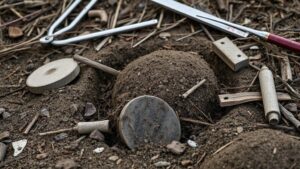Detecting for Military Buttons and Badges on Revolutionary War Sites
Detecting for Military Buttons and Badges on Revolutionary War Sites
The practice of detecting for military buttons and badges on Revolutionary War sites has become an intriguing area of interest for historians, hobbyists, and archaeologists alike. These artifacts hold significant historical value, as they can provide insight into the social, military, and cultural contexts of the 18th-century American colonies. This article will explore the methods, significance, and findings related to detecting military buttons and badges on historical battlefields and encampments.
The Historical Context of Buttons and Badges
Military buttons and badges served not only as functional items but also as symbols of loyalty, rank, and regiment. During the Revolutionary War, various factions used these items to denote uniforms and affiliations, making them vital for identification in the chaos of battle. Historical records indicate that buttons typically featured insignias or engravings that denoted the wearer’s regiment or rank, making them invaluable for both collectors and researchers.
- The Continental Army used a diverse array of buttons, often made from materials such as brass, copper, and pewter.
- Loyalist troops had distinct insignias, differentiating them from patriot forces.
Methods of Detection
Detecting for military buttons and badges typically involves the use of metal detectors, often combined with a systematic excavation approach. The choice of a detector is crucial; modern detectors can differentiate between various metals and types of signals, which is essential for locating buttons and badges specifically.
- Metal Detectors: The use of high-frequency detectors allows for better sensitivity to small metal objects such as buttons.
- Ground Scanning: Ground penetrating radar (GPR) can be effective in identifying buried objects without invasive digging.
Case Studies of Successful Finds
Several sites across the United States have yielded fascinating discoveries through button and badge detection. For example:
- At the site of the Battle of Brandywine in Pennsylvania, detectors uncovered multiple buttons from both Continental and British soldiers, shedding light on the composition of regiments involved in the encounter.
- Another significant find occurred at a Revolutionary War encampment in New Jersey, where attendees discovered a trove of buttons that helped identify troop movement patterns and deployment strategies.
Significance of Artifacts
The discovery of military buttons and badges is profound. These artifacts contribute valuable information to the historical narrative of the Revolutionary War, documenting not just the technological aspects of military uniforms but also the social hierarchies within the military structure. Buttons often display unique designs and engravings that can pinpoint the specific regiment, which helps historians piece together the complexities of troop movements and alliances during the war.
Legal Considerations and Ethics
With the growing popularity of metal detecting, ethical considerations and legal constraints must be addressed. Detecting sites on protected historical lands without permission is often illegal and can lead to significant penalties. So, it is crucial for detectorists to:
- Obtain necessary permits before metal detecting on historical sites.
- Report finds to local historians or archaeological authorities.
Future of Detection in Historical Research
The future of detecting for military buttons and badges on Revolutionary War sites is promising. advancements in technology, including improved metal detection capabilities and data analysis software, will enhance researchers’ ability to recover and analyze artifacts. Also, community engagement through volunteer programs can support further exploration of historical sites.
Actionable Takeaways
For those interested in exploring military artifacts from the Revolutionary War through detecting, consider the following steps:
- Research and connect with local historical societies for guidance and collaboration opportunities.
- Invest in a quality metal detector suited for small metallic objects, preferably with adjustable frequency settings.
- Participate in organized treasure hunts or archaeological digs to gain experience and knowledge.
- Stay informed about legal requirements and ethical standards concerning artifact recovery.
By engaging in responsible detecting practices, individuals can contribute to the collective understanding of Revolutionary War history while uncovering tangible links to the past.


